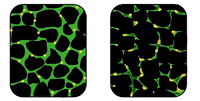
Photo from wikipedia
Duchenne muscular dystrophy (DMD) is a lethal X-linked childhood muscle wasting disease caused by mutations in the dystrophin gene. Nanobiotechnology-based therapies (such as synthetic nanoparticles and naturally existing viral and… Click to show full abstract
Duchenne muscular dystrophy (DMD) is a lethal X-linked childhood muscle wasting disease caused by mutations in the dystrophin gene. Nanobiotechnology-based therapies (such as synthetic nanoparticles and naturally existing viral and nonviral nanoparticles) hold great promise to replace and repair the mutated dystrophin gene and significantly change the disease course. While a majority of DMD nanotherapies are still in early preclinical development, several [such as adeno-associated virus (AAV)-mediated systemic micro-dystrophin gene therapy] are advancing for phase I clinical trials. Recent regulatory approval of Ataluren (a nonsense mutation read-through chemical) in Europe and Exondys51 (an exon-skipping antisense oligonucleotide drug) in the United States shall offer critical insight in how to move DMD nanotherapy to human patients. Progress in novel, optimized nano-delivery systems may further improve emerging molecular therapeutic modalities for DMD. Despite these progresses, DMD nanotherapy faces a number of unique challenges. Specifically, the dystrophin gene is one of the largest genes in the genome while nanoparticles have an inherent size limitation per definition. Furthermore, muscle is the largest tissue in the body and accounts for 40% of the body mass. How to achieve efficient bodywide muscle targeting in human patients with nanomedication remains a significant translational hurdle. New creative approaches in the design of the miniature micro-dystrophin gene, engineering of muscle-specific synthetic AAV capsids, and novel nanoparticle-mediated exon-skipping are likely to result in major breakthroughs in DMD therapy. WIREs Nanomed Nanobiotechnol 2018, 10:e1472. doi: 10.1002/wnan.1472 This article is categorized under: Biology-Inspired Nanomaterials > Protein and Virus-Based Structures Therapeutic Approaches and Drug Discovery > Emerging Technologies.
Journal Title: Wiley interdisciplinary reviews. Nanomedicine and nanobiotechnology
Year Published: 2018
Link to full text (if available)
Share on Social Media: Sign Up to like & get
recommendations!